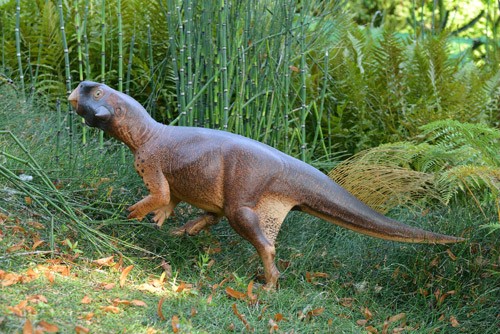By Ana Verayo, | September 16, 2016

Psittacosaurus photographed in the Bristol Botanic Garden
Thanks to new technology, paleontologists have been able to determine the true colors of preserved dinosaur pigments recently discovered in Asia.
In a new study, researchers were able to take a look at the pigments of dinosaurs. This provided crucial clues about the specific species and its habitat.
Like Us on Facebook
The new findings suggest that the Psittacosaurus dinosaur was light colored on its belly side and darker on top. The discovery revealed that this dinosaur lived in an environment filled with diffused light, such as a forest where sunlight is filtered by thick foliage.
Scientists also determined that this unique coloration of the Psittacosaurus served as camouflage.
The Psittacosaurus thrived in Asia about123 to 100 million years ago, during the early Cretaceous period. It possessed a bird-like beak for its nose. Scientists have described this ancient creature as a "parrot lizard."
During the discovery of a psittacosaur fossil in China, scientists began investigating the species' coloration and skin pigment including its preferred habitat. The remains of the dinosaur consisted of bones containing preserved melanosomes that carry the pigment melanin.
Using a 3D model of the specimen, scientists were able to determine which pigments belonged to which part of the dinosaur's body.
According to paleontologist Bob Nichols from the University of Bristol, this Psittacosaurus was reconstructed from inside out, revealing thousands of scales in multiple shapes and sizes, most of them partially pigmented.
The 3D model revealed a gradient pattern from a dark top to a light underside, a pigmentation that would have provided the perfect camouflage in the forest. Now, scientists not only know now how dinosaurs appeared in their environment but by determining their real colors, they can gain a more accurate image of extinct ecologies.
This study has been published in the journal Current Biology.
-
Use of Coronavirus Pandemic Drones Raises Privacy Concerns: Drones Spread Fear, Local Officials Say

-
Coronavirus Hampers The Delivery Of Lockheed Martin F-35 Stealth Fighters For 2020

-
Instagram Speeds Up Plans to Add Account Memorialization Feature Due to COVID-19 Deaths

-
NASA: Perseverance Plans to Bring 'Mars Rock' to Earth in 2031

-
600 Dead And 3,000 In The Hospital as Iranians Believed Drinking High-Concentrations of Alcohol Can Cure The Coronavirus

-
600 Dead And 3,000 In The Hospital as Iranians Believed Drinking High-Concentrations of Alcohol Can Cure The Coronavirus

-
COVID-19: Doctors, Nurses Use Virtual Reality to Learn New Skills in Treating Coronavirus Patients







